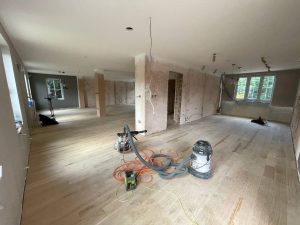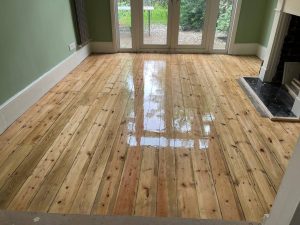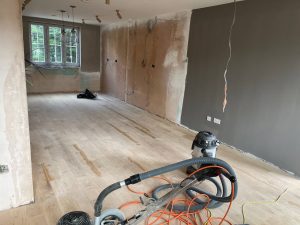The Difference Between Floor Sanding and Refinishing

Understanding the Best Options for Your London Home
Introduction
Maintaining the beauty of wooden floors requires regular care and occasional professional intervention. Two common processes to restore the look of your floors are sanding and refinishing. While they might seem similar, they serve different purposes. In this post, we will explore the differences between floor sanding and refinishing and help you decide which is right for your London home.
What is Floor Sanding?

Floor sanding involves removing the top layer of your wooden floors to eliminate imperfections such as scratches, stains, and uneven surfaces. This process is typically done using a floor sanding machine, which grinds down the surface to reveal fresh wood beneath. Sanding is essential for floors that have significant wear and tear or damage.
What is Floor Refinishing?

Floor refinishing, on the other hand, involves applying a new protective finish to your wooden floors after sanding. This can include stains, sealants, or varnishes that enhance the wood’s appearance and provide a protective layer. Refinishing can also be done without sanding if the floors are in good condition and only need a new coat of finish to restore their shine.
When to Choose Floor Sanding
You should consider floor sanding when:
- There are deep scratches, dents, or stains that can’t be removed with cleaning.
- The floor has uneven surfaces or splinters.
- The current finish is peeling or worn away, exposing the bare wood.
- You want to change the colour or stain of the wood significantly.
When to Choose Floor Refinishing
Floor refinishing is suitable when:
- The floor has minor scratches or wear but is otherwise in good condition.
- You want to refresh the existing finish without changing the colour.
- The protective layer is thinning but the wood underneath is intact.
- You want to maintain the floor’s current appearance with a new layer of protection.
The Process of Sanding and Refinishing
When you choose to sand and refinish your floors, the process typically involves these steps:
- Preparation: The area is cleared of furniture and thoroughly cleaned.
- Sanding: Using a floor sander, the top layer of wood is removed to eliminate imperfections.
- Repair: Any holes or cracks are filled, and the floor is smoothed out.
- Staining (Optional): If you want to change the colour of the wood, a stain is applied.
- Finishing: A protective finish is applied, usually in several coats, to seal and protect the wood.
- Drying and Curing: The floor is left to dry and cure, ensuring a durable and long-lasting finish.
Conclusion
Understanding the difference between floor sanding and refinishing can help you make the best decision for your wooden floors. Whether your floors need a complete overhaul or just a touch-up, choosing the right process can restore their beauty and extend their life. For professional advice and services in London, contact us today. We’re here to help you achieve stunning results for your home.







How to Choose the Right Floor Sanding Finish for Your Lifestyle
How to Choose the Right Floor Sanding Finish for Your Lifestyle Find the Perfect[Read more...]
How to Create Custom Floor Designs with Sanding and Staining
How to Create Custom Floor Designs with Sanding and Staining Transform your London home[Read more...]
Floor Sanding for Stairs: Techniques and Tips
Floor Sanding for Stairs: Techniques and Tips Enhance the beauty and longevity[Read more...]
Cork Tile Sanding
Cork is an environmentally friendly, green resource for flooring, easy to maintain, provides thermal and[Read more...]
How to Achieve a Rustic Look with Floor Sanding
How to Achieve a Rustic Look with Floor Sanding Transform your London home with[Read more...]
How to Plan a Floor Sanding Project for Large Spaces
How to Plan a Floor Sanding Project for Large Spaces Planning a floor sanding[Read more...]
How to Protect Your Furniture During Floor Sanding
How to Protect Your Furniture During Floor Sanding Expert Tips to Keep Your Belongings[Read more...]
Varnishing
[Read more...]
The Benefits of Professional Floor Sanding for Offices
The Benefits of Professional Floor Sanding for Offices Maintaining the floors in your office[Read more...]
DIY Floor Sanding: Pros, Cons, and Tips
Floor sanding is a crucial step in restoring and maintaining the beauty of your wooden[Read more...]